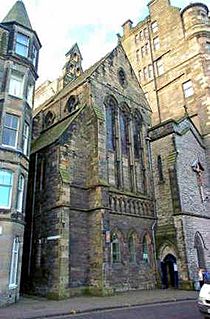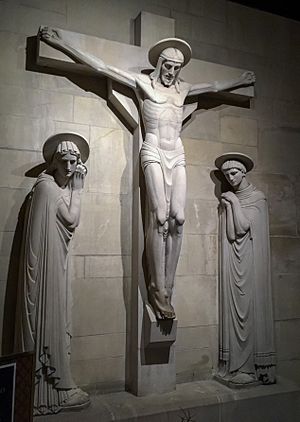Old St Paul's, Edinburgh facts for kids
Quick facts for kids Old Saint Paul's, Edinburgh |
|
|---|---|

Old Saint Paul's, Jeffrey Street, Edinburgh
|
|
| Denomination | Scottish Episcopal Church |
| Churchmanship | Anglo-Catholic |
| Website | http://www.osp.org.uk |
| History | |
| Dedication | Paul the Apostle |
| Administration | |
| Diocese | Diocese of Edinburgh |
Old Saint Paul's is a very old church in the middle of Edinburgh's historic Old Town in Scotland. It belongs to the Scottish Episcopal Church. This church is part of the wider Anglican Communion, a group of Christian churches around the world.
The Scottish Episcopal Church is different from the main Church of Scotland. It kept an older style of church leadership. Old Saint Paul's was one of the first churches to be part of this group. Its first members actually came from Saint Giles' Cathedral in the city.
Contents
Discovering Old Saint Paul's History
Even though the building you see today was built in the 1800s, Old Saint Paul's has a history that goes back over 300 years. It started at the very beginning of the Scottish Episcopal Church.
How the Church Began
The first group of people who formed Old Saint Paul's left Saint Giles' Cathedral. Saint Giles' had become Edinburgh's main church in 1634. In 1689, the last bishop at Saint Giles', Alexander Rose, left the Cathedral. Many of his followers went with him.
They started a new place to worship in an old wool store. This building was in a place called Carrubber's Close. This spot is very close to where Old Saint Paul's stands today.
The Church and Scottish History
Many people in the Scottish Episcopal Church supported the Jacobites. The Jacobites were loyal to King James and his family. Members of Saint Paul's were involved in the Jacobite struggles. This included the uprisings in 1715 and 1745.
For example, one person from the church brought exciting news to Edinburgh. They told everyone about Bonnie Prince Charlie's victory at Prestonpans. They even helped close the town gates against the defeated army.
A Time of Challenges
Because of these uprisings, Episcopalians and their churches faced difficulties. Laws were made that made it hard for them to practice their faith openly. This situation slowly changed after Bonnie Prince Charlie passed away in 1788.
After that, people stopped connecting Episcopalians with the Jacobite cause. The strict laws were slowly removed. In that same year, the Scottish Synod (a church council) decided that prayers for King George III would be said in all Episcopal Churches.
Exploring the Church Building
The current church building was designed by architects Hay and Henderson. It was built in a style called Early English. The church was finished in 1883 and cost about £3500. Mr. Hay had learned from Sir Gilbert Scott. Sir Gilbert Scott designed Saint Mary's Episcopal Cathedral in Edinburgh.
Inside the Church
The church has been made longer two times since it was first built. These additions have made the building three times its original length. The floor in the chancel (the area near the altar) has been raised. It is now covered with beautiful marble.
The high altar is made of carved oak wood. It has a special design with grapevines. On top of it is a slab of porphyry, a type of rock. Seven lamps near the altar represent the gifts of the Holy Spirit. Behind the altar is the reredos, a decorated screen made of gilded oak. It was designed in 1896.
The tall, narrow windows, called lancet windows, show pictures of the crucifixion. On either side are images of Saint Paul and Saint Columba. The roof of the nave (the main part of the church) is a special type called a hammerbeam roof. It has wooden gargoyles, which are decorative carvings. The pulpit, where sermons are given, is made of carved oak. It has figures of saints and was built in 1892.
The Warriors' Chapel
A special memorial chapel was built in 1926. It is sometimes called the Warriors' Chapel. This chapel remembers the lives lost in the First World War. Sir Matthew Ochterlony designed it. The church's leader at the time, Canon Albert Ernest Laurie, helped organize this project.
The chapel holds special lists of honor from both World Wars. It also has the Martyrs' Cross. This small iron cross used to hang in the Grassmarket. It was the last thing some people saw before they passed away. Today, this chapel often displays a painting by Alison Watt, a Scottish artist.
Sculpture in the Chapel
At the top of the Calvary Stair, there is a sculpture of the Crucifixion. It was created by Alfred Frank Hardiman in 1926.
The Church Organ
The church's organ was built by Father Henry Willis. It was installed in 1888. A few small changes were made to the organ in 1936. In 1960, it was made electric and larger. A new console with tab stops was added then. More changes to its sound were made in 1968.
The Church Hall
Underneath the church building, there is a large hall. During the Edinburgh Fringe, which is a big arts festival, this hall changes. It becomes a performance space called theSpace @ Venue 45. This space is run by a group called theSpaceUK.


